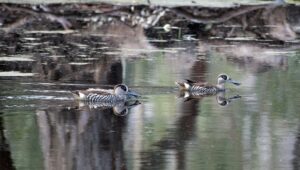Bird of the Month: Pink-eared Duck
Posted on 22 April, 2025 by Lori
Welcome to Bird of the Month, a partnership between Connecting Country and BirdLife Castlemaine District. Each month we’re taking a close look at one special local bird species. We are blessed to have the brilliant Jane Rusden and Damian Kelly from BirdLife Castlemaine District writing these! We’re excited to join forces to deliver you a different bird each month, seasonally adjusted, and welcome suggestions from the community.
Pink-eared Duck (Malacorhynchus membranaceus)
 The Pink-eared Duck is quite a distinctive bird with zebra-like stripes and a large bill. Strangely, the pink patch behind the eye which gives the bird its popular name is barely visible from a distance. Like some other species of duck, it is a nomad and can be found across wide areas of Australia except the larger deserts. It has a preferred habitat of shallow swamps and ponds often left behind by flooding events.
The Pink-eared Duck is quite a distinctive bird with zebra-like stripes and a large bill. Strangely, the pink patch behind the eye which gives the bird its popular name is barely visible from a distance. Like some other species of duck, it is a nomad and can be found across wide areas of Australia except the larger deserts. It has a preferred habitat of shallow swamps and ponds often left behind by flooding events.
It has a distinctive spatulate bill that aids in filtering food from the water. Feeding can occur in groups with a flotilla of birds in parallel moving across the water. At other times it performs what has been referred to as “vortexing” with two birds moving in a circle, rotating around a fixed point. This is probably used to concentrate aquatic insects into a smaller area. Food includes insects, shrimp, crustaceans and yabbies.
Breeding occurs at any time of the year once a sufficient supply of food have bred up after floods. Nests are often congregated in small areas and may be built in tree hollows, on fence posts, in the fork of trees or on stumps, usually over water. In some areas with high populations more than one bird may lay in a nest and parenting can be spread around a bit. The nest is lined with down. See photo of a nest at Bell’s Swamp taken a few years ago which was low over the water. You can see the large amount of down used. The female does the incubating but both parents look after the young.
In the 1950’s huge concentrations were recorded with estimates of more than 96,000 Pink-eared Ducks breeding along long stretches of water after floods in the Riverina in NSW. In recent times no such large concentrations have been observed. Numbers vary widely and at times it can be at risk from shooters.








Leave a Reply